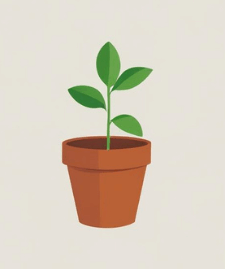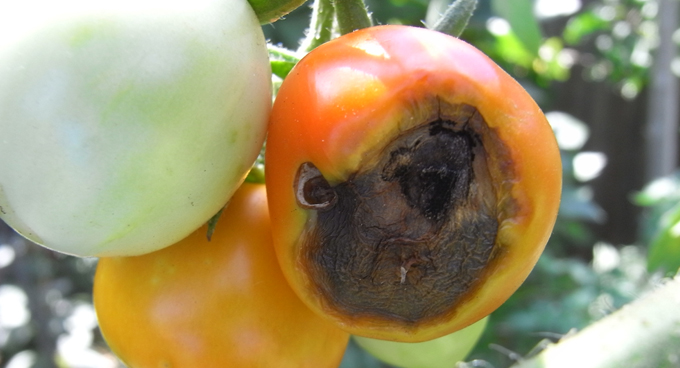The best way to stop blossom end rot in tomatoes is to try and prevent it from happening in the first place. Having your tomato crop ruined by blossom end rot is very frustrating. After putting in lots of time and effort it’s hugely disappointing to lose parts of your harvest. Also once it starts it’s very hard to reverse. You can, however, limit the damage if you catch it early enough.
10 Ways To Stop Blossom End Rot in Tomatoes
- Avoid large variations in soil moisture (water consistently)
- Don’t start growing in wet conditions
- Don’t grow in cold soil
- Don’t over fertilizer
- Make sure your soil pH is correct
- Get your levels of nitrogen right
- Limit root damage when turning soil
- Add mulch
- Use hardy tomato varieties
- Test your soil
What causes Blossom End Rot in Tomatoes?
Before we get started it makes sense to explain what causes blossom end rot in the first place. Blossom end rot is not a disease. It is a mineral deficiency.
If tomatoes don’t get enough calcium, the end of the fruits start to go black and end up rotting. A soil without enough calcium is sometimes a cause.
So this is one of the important areas to look at. Most soils will actually have enough calcium anyway. But testing your soil before you start is till a good idea.
What tends to be more important than calcium in the soil is the condition of the tomato plant roots and the soil.
Because minerals are taken up through the roots, any damage to the roots or anything that affects the roots ability to take up minerals is an important factor.
Soil conditions and root health are therefore two very important things to think about.
Soil conditions can be affected by temperature, water content, fertilizers, compost content and the type of soil itself.
Root health can be affected by any of the above factors plus of course digging and weeding which can cause serious damage to the roots if you’re not careful.
In the detailed list below you can see how to manage all of those situations to reduce your chances of getting blossom end rot.
With a bit of careful thought and consideration you can greatly lower the chances of your plants getting blossom end rot.
Tips To Stop Blossom End Rot in Tomatoes
1. Avoid Large Variations in Soil Moisture
One of the best ways to prevent blossom end rot in your tomatoes is to keep your soil moisture constant. If the soil moisture fluctuates too much this affects the roots. Either they will be too wet or too dry.
The roots are then unable to take up nutrients as well as normal. When calcium isn’t taken up properly this leads to blossom end rot.
Keeping the soil moisture reasonably constant or within a healthy range allows calcium to be absorbed and keep a good nutrient balance.
If the weather is very dry you will need to water the soil twice a week. I would advise adding enough water to moisten the soil to around six inches in depth. You can stick your fingers into the soil to check.
One way of helping to even the moisture in your soil is to use aqua cones. These release water as the soil needs it. This stops over watering or dehydration of the soil.
2. Don’t Plant in Wet Conditions
Planting in wet conditions is difficult for the plant as well as you. The soils is thick and clumpy and it’s not easy to give the roots a gentle introduction to their new home.
When soil is wet the air gaps between granules tend to fill up and working with the soil is hard. The soil forms sticky lumps and is very heavy.
You can’t make a nice hole in what should be light soil for the starter plant to go into. The plant will be in a too tightly packed a space and the soil very unwelcoming.
In this kind of heavy, thick soil the roots can be damaged and they find it difficult to establish themselves.
As we know damage to roots is the last thing we want. Wait for a few days until the soil is dry and pant away.
3. Don’t Grow in Cold Soil
Tomato plants don’t grow well in the cold. The cold will badly affect root growth which in turn reduces the plants ability to take up nutrients.
Remember blossom end rot is caused by a lack of nutrients. Specifically calcium. With underdeveloped roots there is little chance of the plant and roots getting the food they need.
Avoid starting in cold weather if you can. It’d best to wait until well into spring and there is no chance of the ground freezing.
4. Don’t Over Fertilize
It can be tempting to add lots of fertilizer thinking this will help your harvest. What happens when you add too much fertilizer is that there is a build up of salts and nitrogen in the soil around the plants.
Although nitrogen is great for stem and leaf growth it also inhibits the growth of fruits. Too much nitrogen will promote a strong vine and leaves but slow down the growth of fruits at the same time.
Too many salts can affect the plant in many different ways. Yellowing of the leaves, rotting roots, wilting leaves, slowed growth are just a few possible side effects.
It shouldn’t surprise you to know that if the salt concentration in the soil is too high, your tomato plant will find absorbing water a lot more difficult than usual.
Hence the wilting of leaves and discolouring. Make sure you follow instructions carefully on any tomato fertilizer that you buy.
5. Make Sure Your pH is Correct
If you don’t know already, pH measures how acidic or alkaline soil is. The pH scale goes from 1-14. 1 is very acidic and 14 is very alkaline. 7 is neutral. For example, water is 7 and hydrochloric acid is 1.
The ideal pH for tomato soil is from 6.0 to 6.8. You can test your soil with a cheap and easy home kit.
If the pH of your soil is too high, adding lime helps to raise the pH back to a better level. If you have a high pH you should add some sulphur.
6. Get Your Levels of Nitrogen Right
I mentioned this earlier when talking about over fertilizing. Nitrogen is an important nutrient but must be given in the right amounts.
Too much nitrogen will produce strong vines and lush leaves but will also slow down fruit development.
Most fertilizers contain three main nutrients. Nitrogen, phosphorous and potassium. You need them in the right balance to feed both the plant and the fruits.
If this balance is out of sink it can potentially cause your plants many issues.
The easiest way to get the right balance is to pick a specialised tomato fertilizer.
7. Limit Root Damage
Try to limit any damage you might do to the roots of your tomato plant. If you are weeding or turning over earth around your plants be careful not to disturb or break any roots.
As you now know, blossom end rot is caused by a lack of calcium. Damaged roots affect the plants ability to up take nutrients including calcium and can lead to deficiencies.
So be careful when digging around your plants and try to limit any disturbance or breakage to your tomato plant roots.
8. Add Mulch
Mulch is a mix of decaying leaves, grass and organic matter. There are many different kinds but usually they have leaves and grass clippings or wood chips as their main ingredients.
You just add a layer of it on top of your soil and you get a number of benefits.
One of the main benefits of mulch is that it keeps the soil moisture constant. The mulch will absorb a lot of moisture during watering and it slowly releases it into the soil.
A consistent level of moisture keeps the tomato plant roots happy.
It also forms a protective layer on top of the soil slowing down soil moisture evaporation. Water from the top of the mulch is evaporated while the bottom of the mulch stays moist.
This helps to slow down evaporation from the soil and keeps the soil damp for longer.
Mulch is also a great insulator from quickly changing weather conditions. In warm weather the soil is kept cooler, and during a drop in temperature it helps to keep it warmer.
As an added extra, weeds are prevented from growing. Weeds find it difficult to grow through the mulch layer. If any manage to poke their way through, they are then pretty easy pickings.
At the end of the season you can mix the mulch into the soil to give it extra nutrients.
9. Use Tough Tomatoes
If you pick certain tomato varieties this will increase your chances of avoiding blossom end rot.
Smaller tomatoes are better at resisting the calcium deficiency and some tomatoes are far more susceptible. Plumb tomatoes, pear and elongated tomato varieties are more likely to get the disease.
Cherry tomatoes almost never suffer from blossom end rot.
A study was carried out by the University of Illinois to see which tomatoes were good at resisting blossom end rot. They found a few varieties that have low incidence even in years where the calcium deficiency was a large problem.
This list of varieties had less than 10% blossom end rot even in bad years.
- Celebrity
- Fresh Pack
- Jet Star
- Manapal
- Mountain Pride
- Pik Red
- Sunny
- Winter
This list had 10-30% blossom end rot in bad years.
- Big Boy
- Castle King
- Fantastic
- Independence
- Supersonic
- Surprise
- Whopper
- Wonder Boy
10. Test Your Soil
As well as the pH test, you can do a more thorough test to show the mineral make up of your soil. Although the pH test is good it’s not giving you the full picture.
With a full soil test you get to know what minerals are in your soil and at what levels. With test you will need to take a soil sample form you garden and send it off to a lab.
The great advantage of this test is that you will get a report telling you exactly what you need to add to your tomato garden to give it the right conditions.
When you take a sample make sue you take it from various parts of your planting area and get under the soil to about six inches.
Mix all the sample you have taken together and send that mixture off to the lab.
We hope our ten tips on how to stop blossom end rot in tomatoes were helpful. Please ask any questions in the comments.


